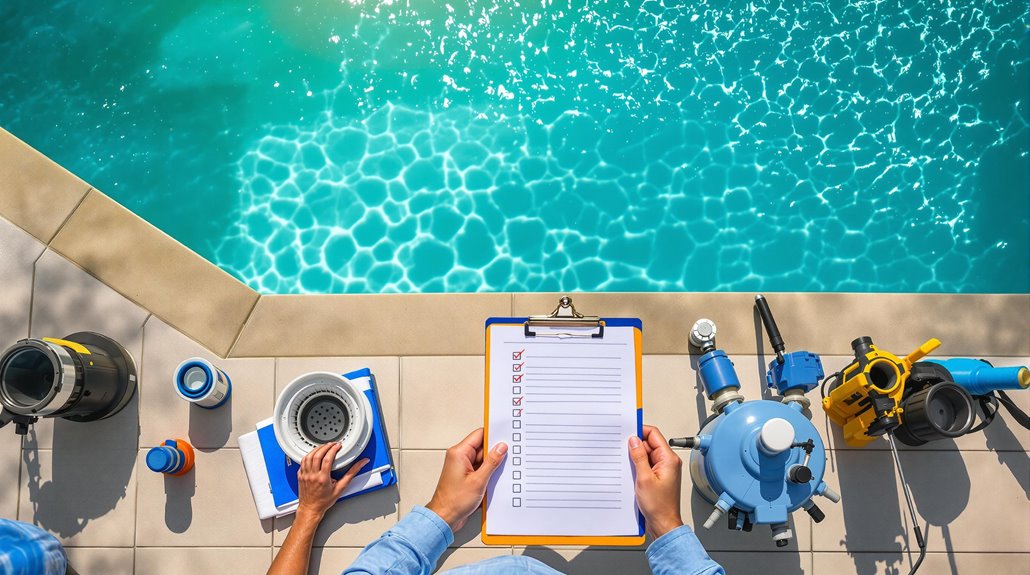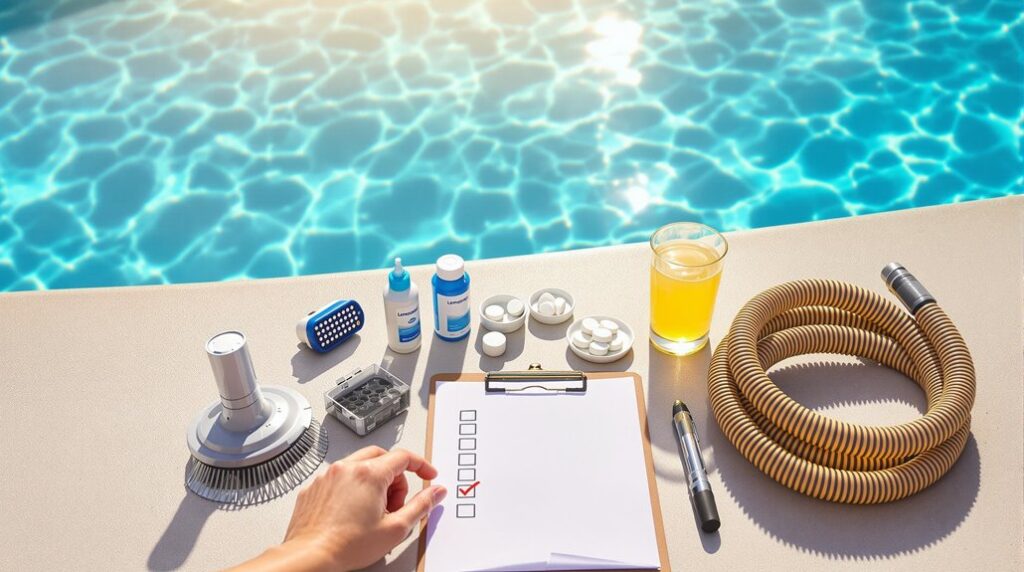To get your pool summer-ready, start by inspecting the shell, tiles, and equipment for damage. Test and balance your water chemistry, focusing on pH, alkalinity, and calcium hardness levels. Clean the pool thoroughly, including skimming, brushing, and vacuuming. Maintain proper filtration by checking pump performance and cleaning filters. Create a maintenance schedule for daily, weekly, and monthly tasks to guarantee your pool stays crystal clear all season long.
Pool Surface and Equipment Assessment

Five key areas require thorough inspection before you can safely open your pool for summer use. Start by examining your pool’s shell or liner for cracks, chips, and damage that could compromise its integrity. You’ll need to inspect tiles and coping stones, ensuring they’re firmly attached and free from gaps or breaks. Regular algae treatment is essential to prevent unsightly growth and maintain water clarity. Check the deck surface for proper drainage and slip-resistant coating, addressing any standing water issues immediately. Don’t overlook your pool’s essential equipment – test the pump for unusual noises or vibrations, verify filter efficiency, and confirm the heater functions correctly. Regular heater maintenance helps prevent inefficient operation and costly repairs down the line. A weak motor seal is often responsible for strange pump sounds and should be replaced immediately. Regularly cleaning your filter will extend filter life and maintain optimal water circulation. Finally, examine all drain covers and electrical connections, making sure anti-entrapment covers are securely fastened and grounding wires properly connect all equipment to prevent hazards. Be alert for water level changes throughout the season, as this can indicate a potential leak requiring immediate attention.
Balancing Your Water Chemistry
After completing your pool’s physical inspection, you’ll need to focus on achieving proper water chemistry – a multi-step process that requires careful testing and adjustment. Start with alkalinity testing to establish a stable base of 80-120 ppm, then move on to pH balancing between 7.2-7.8, and finally address calcium hardness levels. Maintaining crystal clear water depends heavily on proper pH monitoring and adjustment. If your chemical tests reveal imbalances, systematic troubleshooting will help identify and correct specific issues quickly. Poor chemical balance is one of the leading causes of cloudy water issues in pools. Regular year-round maintenance is crucial to prevent chemical imbalances from developing in the first place.
- Test alkalinity weekly and adjust using sodium bicarbonate to increase or muriatic acid to decrease – this prevents pH fluctuations and protects your equipment from corrosion
- Balance pH levels using soda ash to raise or muriatic acid to lower, always wearing protective gear while handling chemicals
- Maintain calcium hardness between 150-250 ppm by adding calcium chloride as needed, testing monthly to prevent scaling and metal component damage
Optimizing Pool Surroundings

Creating an ideal pool environment requires careful attention to both practical and aesthetic elements of your surroundings. Start by evaluating your terrain and positioning your pool to minimize wind exposure while optimizing sunlight. You’ll want to maintain a 3-5 foot debris-free zone and select low-maintenance plants such as succulents to reduce cleanup time.
Install color-changing LED lighting and consider adding water features for visual appeal, but don’t compromise on safety. Use textured decking materials to prevent slips, and guarantee clear sightlines for proper supervision. To boost energy efficiency, plant natural windbreaks or install automatic pool covers – you’ll save hundreds on energy costs annually. Remember to position emergency equipment in visible locations and maintain lockable gates for peace of mind.
Maintenance Schedule and Best Practices
Regular maintenance forms the backbone of a pristine pool, and you’ll need to establish a consistent schedule to keep your water sparkling clean. By following a structured approach, you’ll prevent costly repairs and make certain your pool’s ready whenever you want to plunge into. Take control of your pool’s health with these essential maintenance tasks:
- Perform daily skimming to remove debris, and brush walls weekly to prevent algae buildup – these simple actions will save you time and money in the long run
- Check and clean your filter system regularly, maintaining pressure between 8-15 psi, and don’t forget to lubricate O-rings monthly
- Test water chemistry weekly, adjusting chlorine, pH, and alkalinity levels as needed, with a biweekly shock treatment to eliminate contaminants and keep water crystal clear. Increased shock treatments may be necessary during periods of heavy rainfall or intense pool usage.
Whether you have a traditional chlorine system or a salt chlorinator, maintaining proper chemical balance is crucial for swimmer comfort and equipment longevity. Don’t forget to scrub your pool tile lines regularly to prevent calcium buildup and maintain that professional look. Regular vacuuming is essential to maintain optimal water quality and prevent debris from settling at the bottom of your pool. Maintaining proper circulation throughout your pool helps distribute chemicals evenly and prevents stagnant water zones.
Frequently Asked Questions
How Long Should I Wait After Shocking Before Swimming?
For chlorine-based shocks: 24-48 hours
For non-chlorine shocks: 15-30 minutes
Test water before swimming: chlorine must be below 5 ppm
What’s the Best Time of Day to Run My Pool Pump?
Run pump 2 hours between 10am-2pm for UV protection and 6 hours overnight for efficient chemical circulation.
Can I Use My Pool Immediately After Adding Algaecide?
Wait 30 minutes minimum after adding algaecide before swimming to avoid skin and eye irritation. For optimal safety, wait 1 hour.
Why Does My Pool Water Level Keep Dropping?
Pool water levels drop from:
- Evaporation
- Leaks
- Splash-out
- Mechanical issues
Test for leaks if water drops more than ¼ inch overnight.
Should I Leave My Pool Cover on During Heavy Rain?
Remove your pool cover during heavy rain and strong winds to prevent tearing, debris accumulation, and structural damage.

